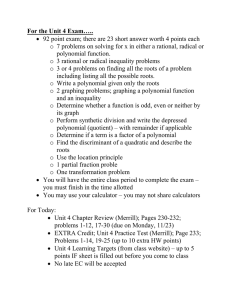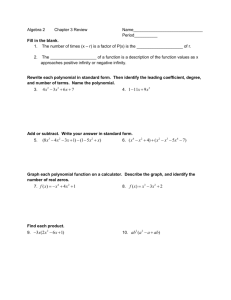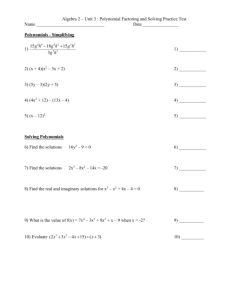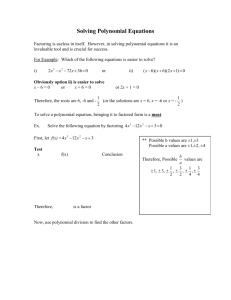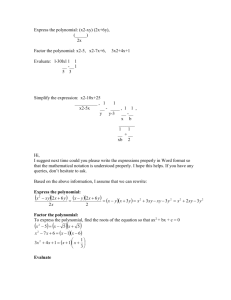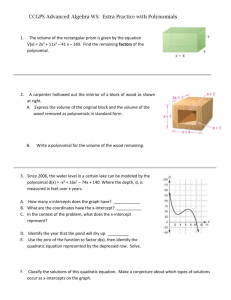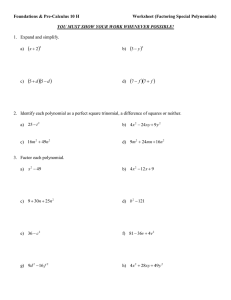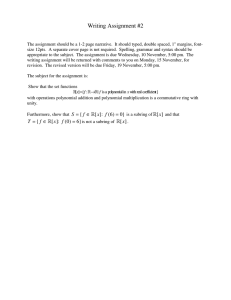Document 10407182
advertisement
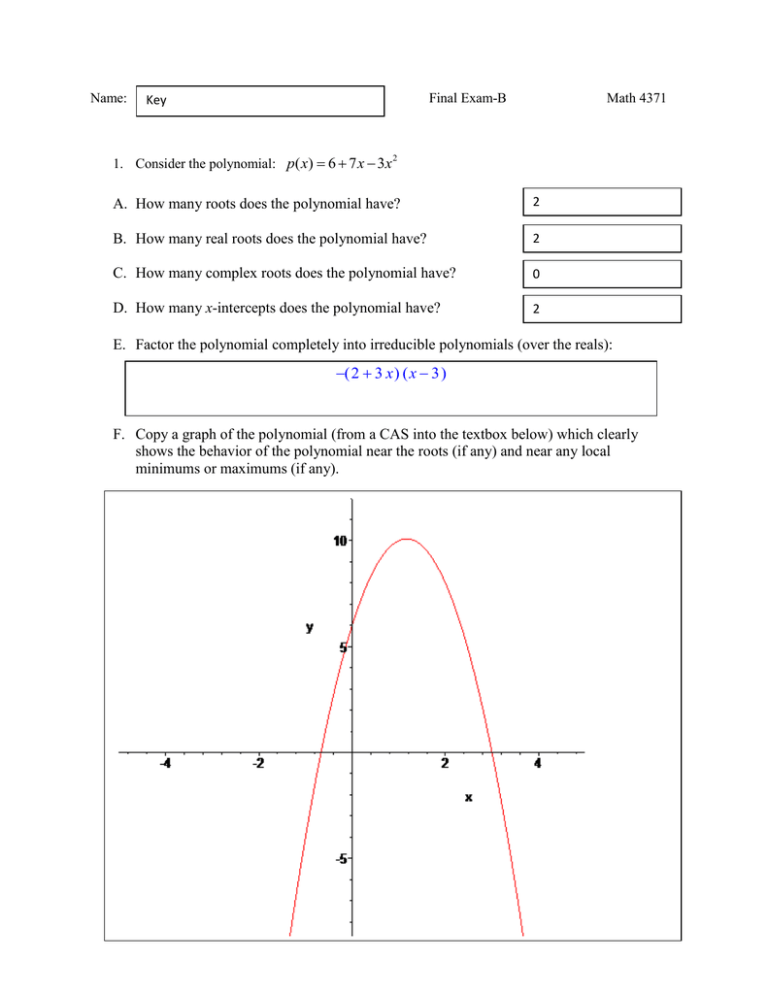
Name:
Final Exam-B
Key
Math 4371
1. Consider the polynomial: p( x) 6 7 x 3x 2
A. How many roots does the polynomial have?
2
B. How many real roots does the polynomial have?
2
C. How many complex roots does the polynomial have?
0
D. How many x-intercepts does the polynomial have?
2
E. Factor the polynomial completely into irreducible polynomials (over the reals):
( 23 x ) ( x3 )
F. Copy a graph of the polynomial (from a CAS into the textbox below) which clearly
shows the behavior of the polynomial near the roots (if any) and near any local
minimums or maximums (if any).
2. Consider the polynomial: q( x) 80 x3 120 x 2 482 x 795
A. How many roots does the polynomial have?
3
B. How many real roots does the polynomial have?
3
C. How many complex roots does the polynomial have?
D. How many x-intercepts does the polynomial have?
0
3
E. Factor the polynomial completely into irreducible polynomials (over the reals):
( 2 x5 ) ( 40 x2160 x159 )
F. Copy a graph of the polynomial (from a CAS into the textbox below) which clearly
shows the behavior of the polynomial near the roots (if any) and near any local
minimums or maximums (if any).
3. Consider the polynomial: r ( x) 18 x 4 63x3 22 x 2 82 x 136
A. How many roots does the polynomial have?
4
B. How many real roots does the polynomial have?
2
C. How many complex roots does the polynomial have?
2
D. How many x-intercepts does the polynomial have?
2
E. Factor the polynomial completely into irreducible polynomials (over the reals):
( x22 x2 ) ( 6 x17 ) ( 3 x4 )
F. Copy a graph of the polynomial (from a CAS into the textbox below) which clearly
shows the behavior of the polynomial near the roots (if any) and near any local
minimums or maximums (if any).
4. Consider the set {1, 1,1 2i,1 2i, 2}
A. Find a polynomial whose roots are exactly the elements of the set . Write the
polynomial out in expanded form:
x52 x411 x10 2 x34 x2
B. How many x-intercepts does the polynomial have?
2 distinct, 3 counting multiplicity
C. Copy a graph of the polynomial (from a CAS into the textbox below) which clearly
shows the behavior of the polynomial near the roots (if any) and near any local
minimums or maximums (if any).
5. Consider the following set of functions:
A.
y1 2 x 2 2 x 5,
y2 2 x 2 x 1,
y4 2 x 2 x 1,
y5 2 x 2 2 x 1
Which of the five functions have only complex roots?
y1
B.
complex
4.5
y3
y4
y5
complex
y2 .88
y3 -1
y4 -1.12
y5
.5
Estimate the x-intercepts of those functions for which real roots exist.
y1
y4
D.
y2 complex
Estimate the minimum value of each function.
y1
C.
y3 2 x 2 1,
y2
-1, .5
y3 -.73, .73
y5
Using a CAS, plot the graphs all five functions on the same coordinate axes. Copy
the plot into the textbox below.
6. Consider the rational function: f ( x)
2 x 2 3x 16
x2 2x 8
A. Does the function have vertical asymptotes? If so, where?
Yes/No Yes
Where?
x=-2, x=4
B. Does the function have a horizontal asymptote? If so, where?
Yes/No Yes
Where?
y=2
C. Does the function have a slant asymptote?
Yes/No No
D. Copy a graph of the function (from a CAS into the textbox below) which clearly shows
the behavior of the function near any intercepts (if any) and also shows the asymptotes (if
any).
7. Consider the rational function: f ( x)
x2 4 x 5
2x 3
A. Does the function have vertical asymptotes? If so, where?
Yes/No Yes
Where?
x=-3/2
B. Does the function have a horizontal asymptote? If so, where?
Yes/No No
Where?
C. Does the function have a slant asymptote?
Yes/No Yes
D. Copy a graph of the function (from a CAS into the textbox below) which clearly shows
the behavior of the function near any intercepts (if any) and also shows the asymptotes (if
any).
8. Using a CAS construct an implicit plot of the equation 2 x 2 5xy 2 . Copy the graph of
the equation from the CAS into the textbox below.
9. Using a CAS construct an plot of the 3-d graph of the function f ( x, y )
Copy the graph of the function from the CAS into the textbox below.
cos( x y )
x2 y 2 2
10. For the following sequence identify the next two missing terms and describe the pattern
that the terms in the sequence follow.
{0,1,1,0,1,1,1,1,0,1,1,1,1,1,1,0,1, 1
Pattern:
, 1
, ...}
0 if n is perfect square, 1 is n is not perfect square
11. For the following recursive sequence identify the next two missing terms and describe the
pattern that the terms in the sequence follow.
{1, 1, 3, 7, 17, 41, 99,
Pattern:
239
, 577
, ...}
An = An-2 + 2*An-1
12. For the following sequence S find the specified missing terms. S is an arithmetic
sequence for which the 5th and 9th terms are 27 and 59, resp.
Find the 1st term and the 27th term: a1 -5
, a27
203
13. For the following sequence S find an explicit functional formula for generating all of the
terms of the sequence and find the 39th term of the sequence. S is the sequence given by
{1, 5, 14, 28, 47, . . . } where the second differences are constant.
Formula: An = 2 +(-7/2)*n + (5/2)*n2
, a39 3668
14. On the back of the instruction’s page for the exam, sketch on the same graph the
derivative and the anti-derivative of function pictured below.
Function = Red
Derivative = Blue
Anti-Derivative = Green
15. In the picture below the graphs of three functions are plotted on the same coordinate axes.
Of the three graphs one is the graph of a function f , one is the graph of the derivative of
f and one is the graph of an anti-derivative of f. Identify which graph is which:
Function = Blue
Derivative =
Green
Anti-derivative = Red
